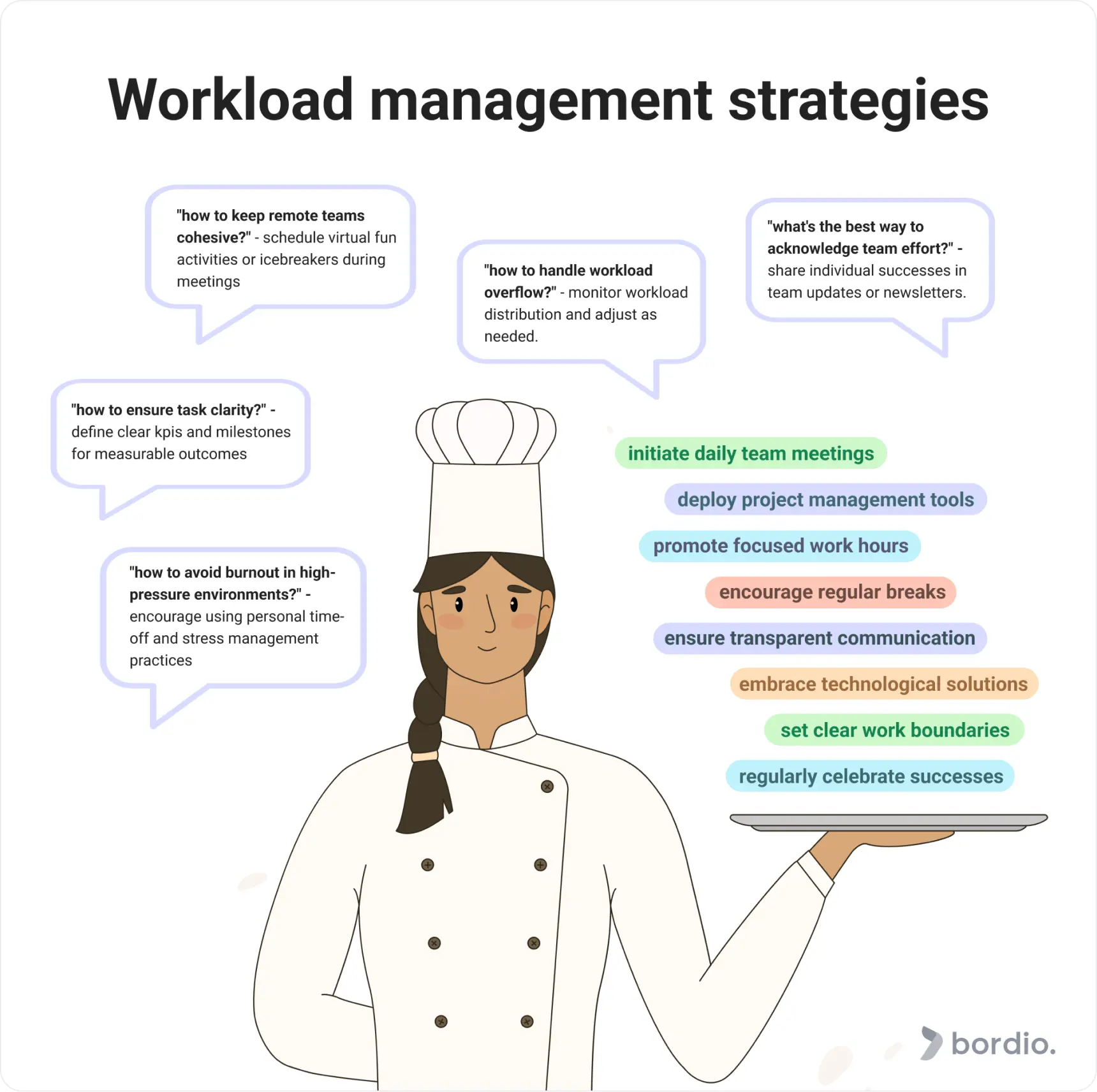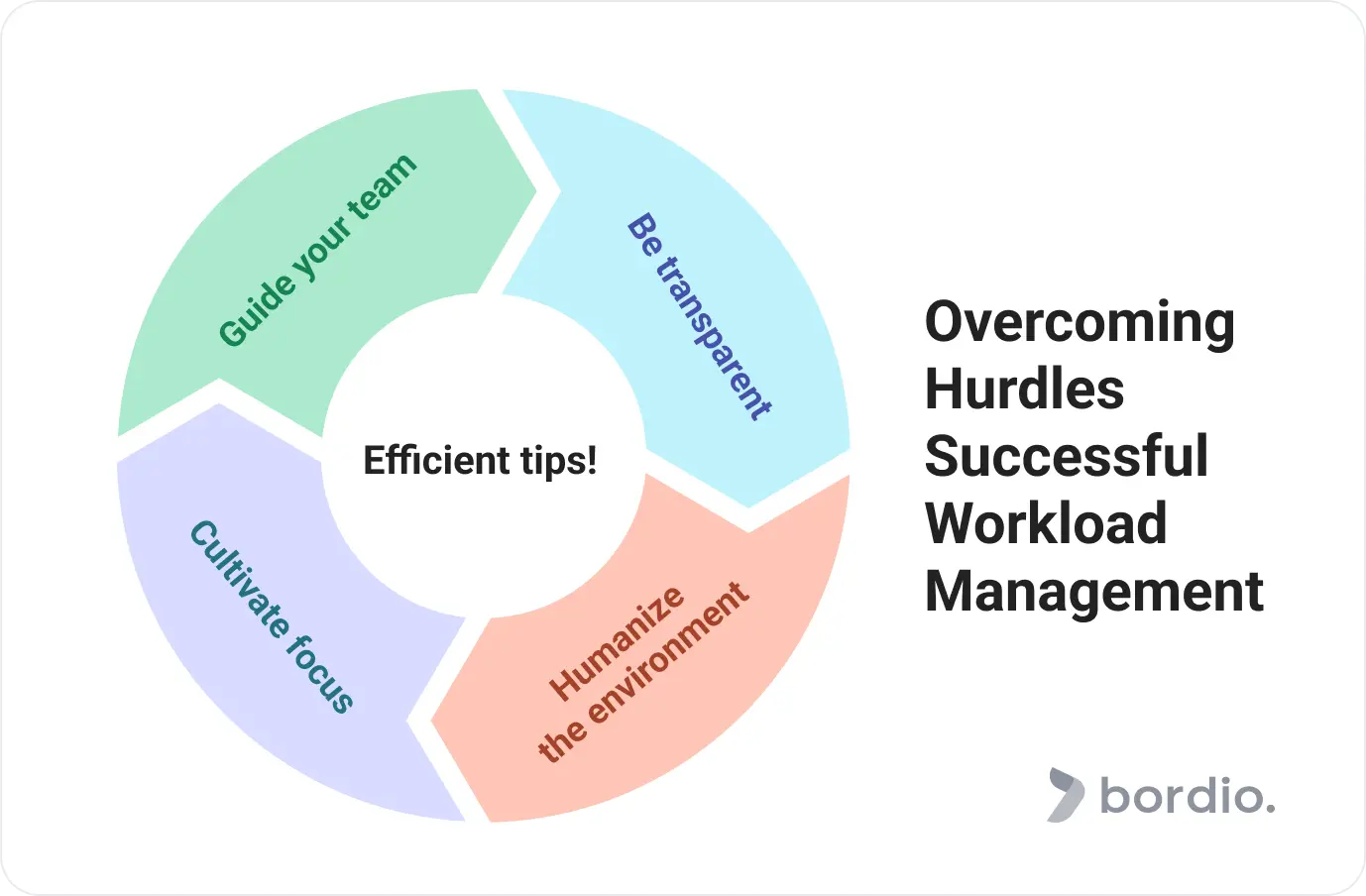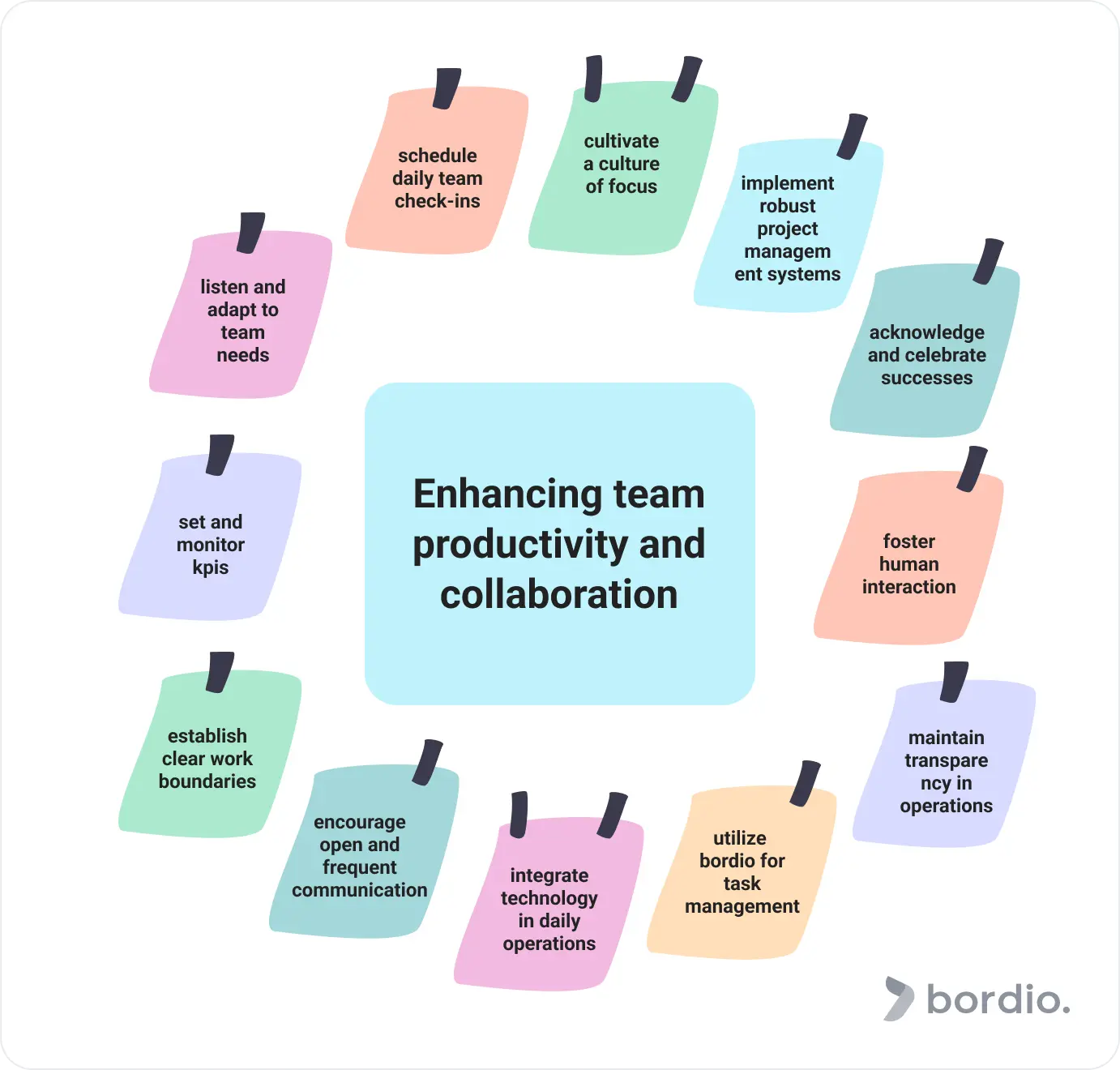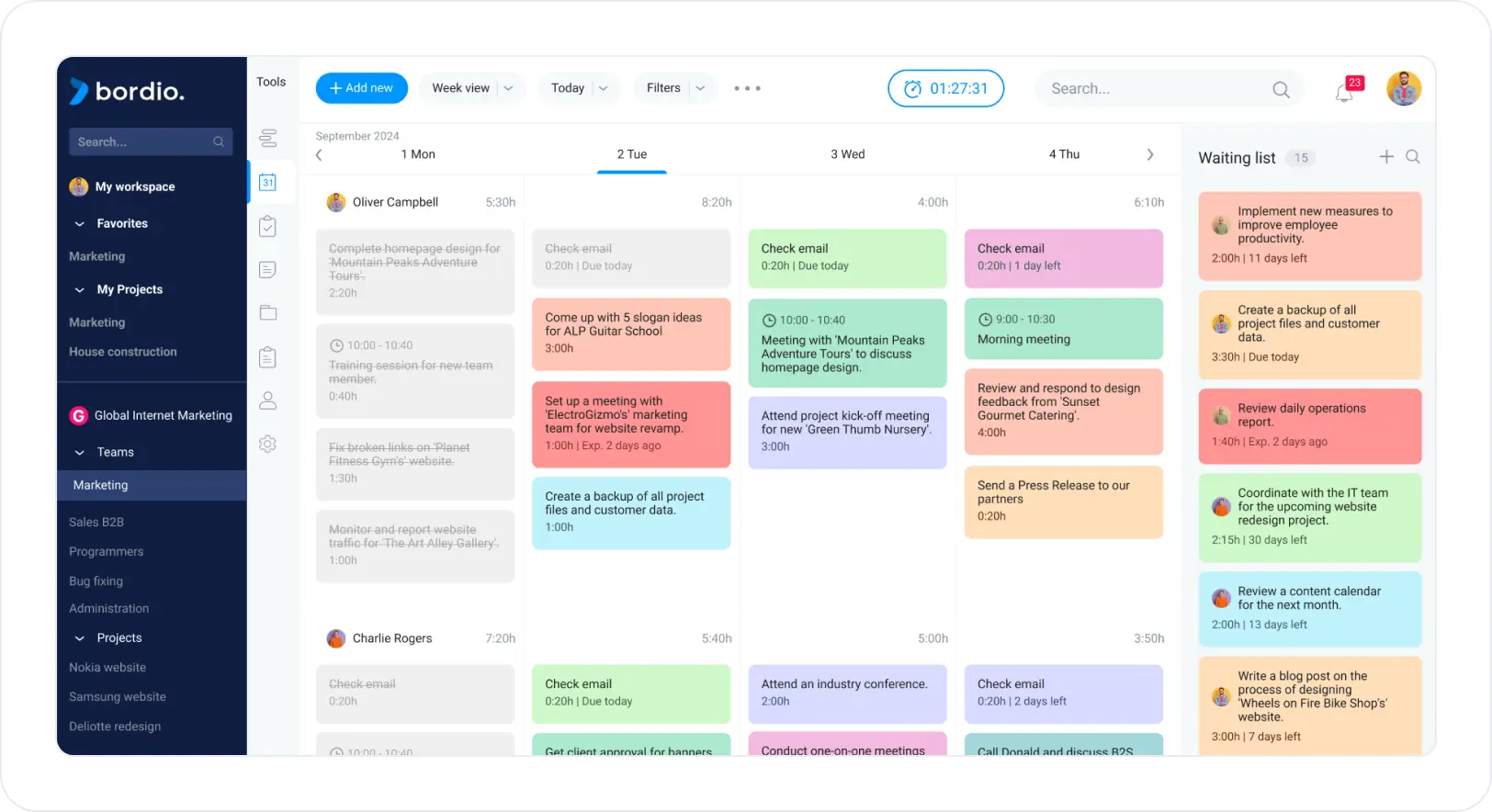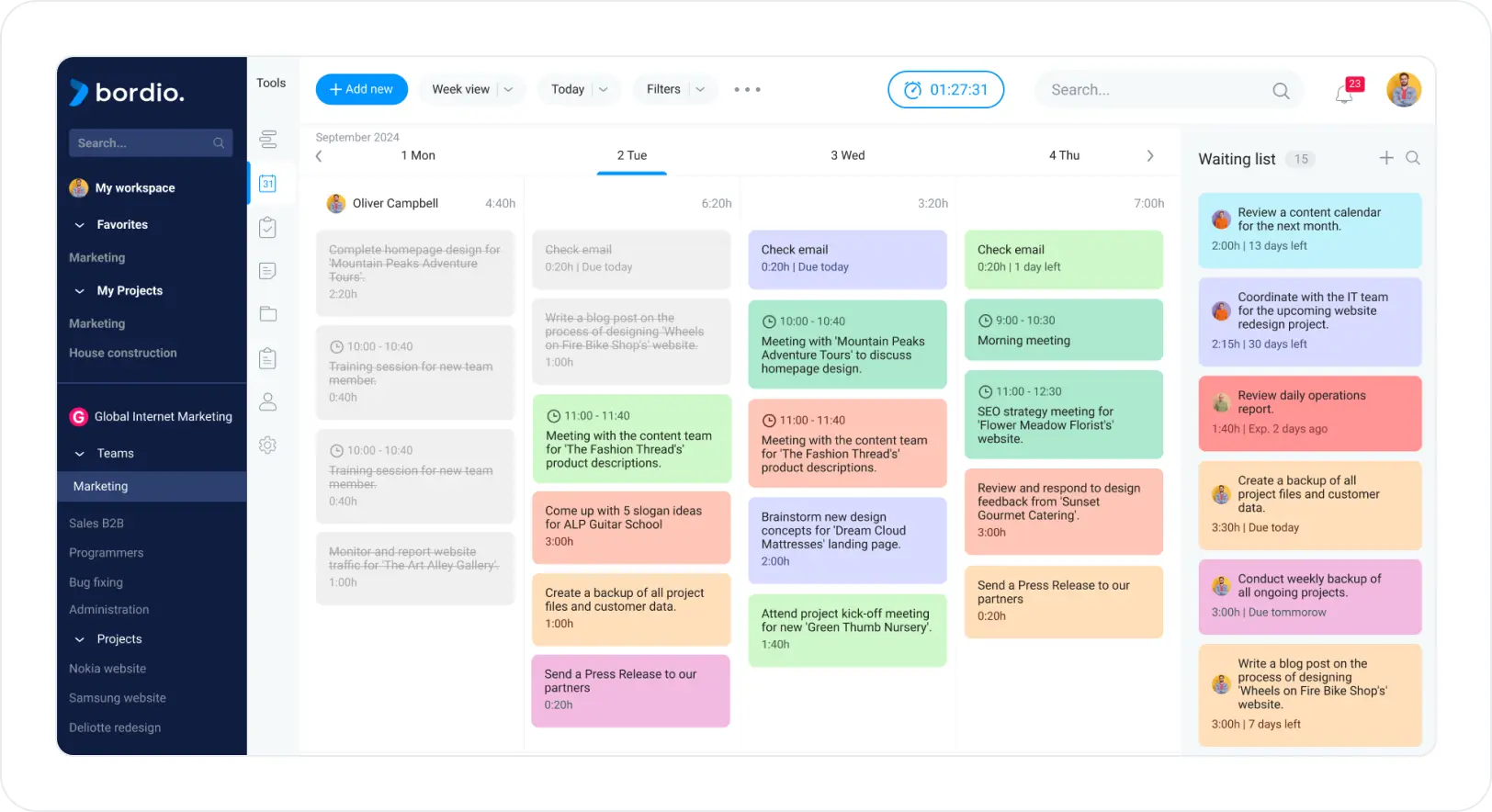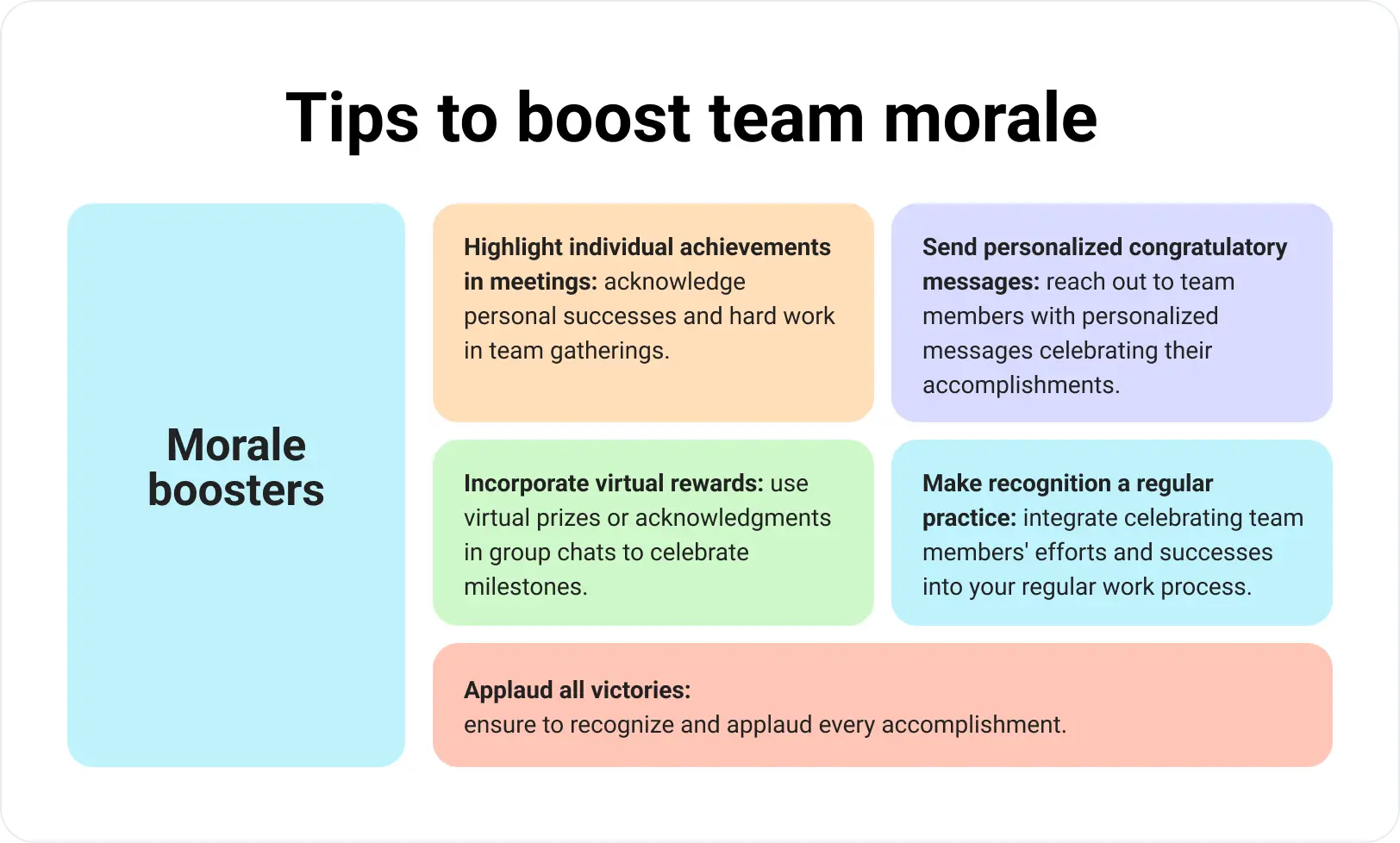Welcome to the fast-paced world of team workload management software, where turning chaos into harmony is more fun and accessible than throwing a pizza party at the office!
In fact, Workload Management may seem like a complex topic, but that’s only at first glance. In short, it’s about helping your team work smarter, not harder. Let’s think of it like a puzzle or a Rubik’s cube, where each piece is a task or responsibility. The goal is to arrange these pieces to make the most sense for everyone involved. This article will examine practical tips and tricks to help you do that. Whether you’re new to team management or an experienced one looking for fresh ideas, these strategies are designed to improve efficiency and keep your team happy and productive. We’ll break these techniques down into simple, easy-to-understand steps, perfect for anyone who has felt the stress of a heavy workload, juggling multiple tasks and coordinating team members. Let’s dive in and find out how to make managing your workload a smooth and efficient process!
Overcoming hurdles for implementing successful workload management strategies
Let’s start with something every team faces, no matter where they work: managing their workload effectively. Let’s use our imagination! It’s like balancing your coffee, phone, and laptop in time across a crowded room—it requires skill capacity planning and strategy, and you want to look graceful. Let’s dive into some key top workload management practices and strategies that can improve your team’s productivity, as effective workload planning and management enhance team efficiency and boost morale. Project managers should take this into account.
Navigating the task jungle
First, we know that intelligent workload management can sometimes feel like an endless game with no rules, with tasks popping up left and right. Team managers, as well as project managers, need to create a transparent and manageable workflow. Think of it as installing traffic lights and signs on a busy street. It ensures smooth operation and prevents failures (or burnouts!).
Guiding your team
One practical approach is to implement a robust project management system. It’s not just about making a digital list of to-dos and urgent tasks to complete; This is your GPS for navigating the jungle of project schedules and administrative tasks. Having a clear picture of project schedules, who is doing what, and when can ensure that no one is overwhelmed while others are slacking off.
Cultivating focus
And let’s talk about the so-called elephant in the room: those pesky distractions that can turn a productive day into hell! We’ve all been there. The key is to foster a culture of self-discipline and focus. Encourage your team to practice “focus hours” where they can work quietly. It’s like giving everyone noise-cancelling headphones for their tasks.
Humanizing the work environment
Also, don’t forget about human interaction. Regular meetings or coffee breaks can help team members feel valued. It brings people together. It’s like watering plants; a little care goes a long way towards motivation.
Transparency
Finally, transparency is your best friend. Keep everyone in the loop with regular updates and open communication channels. It’s similar to an open-door policy, but digitally. This way, everyone will know what’s on the agenda, what’s happening, and what’s changing, and they can always stay on top of the topic and contribute to the common cause more effectively.
Remember that a workload management plan is not just about managing workloads or management skills or getting things done; it’s about doing them to keep the team happy, healthy, and ready to deal with whatever happens or might happen next.
Effective workload management strategies
Let’s look at some practical tips for mastering the workload management process to improve your team’s effectiveness and keep it running smoothly. Whether your team is located in one office or scattered around the world, these workload distribution strategies are like the oil that keeps all parts of the machine running smoothly and without failure.
1. Set up regular team check-ins
Think of regular check-ins as your team’s daily dose of vitamins—necessary and healthy. These meetings should resemble the perfect espresso: strong, efficient, and fast. You can attend a Scrum-style group meeting or cozy virtual coffee chats with team members here. The choice is yours!
Be careful not to overdo it! Managing a team’s workload doesn’t have to be overwhelming. This is not solving a complex mathematical equation. It’s more about just everyone being connected and on the same page. Here’s how it might work:
- Team members join the call.
- They share yesterday’s achievements and plans for today.
- The call is short and sweet, ending in 10-15 minutes.
Voila! These daily meetings are like the glue that holds your remote team together. This is a chance for project managers to align goals, stay in harmony, and maintain team spirit. Put this item on everyone’s daily calendars at the same time every day to make it a routine, like a morning alarm.
Regardless of the format, the main thing is regularity and meaningfulness. Remember that even the happiest remote workers can feel a little isolated. These virtual meetings are like a water cooler: they bring everyone together while keeping the atmosphere upbeat and motivating.
2. Efficient tools for perfect workload management strategy
Have you ever wished there was an easy way to monitor your team’s workload? Meet Bordio, your team’s new best friend, who will help you stay organized and on track. Here’s why it’s a real hit:
- Setting time estimates: Bordio allows you to specify how long each task should take, almost like setting a timer for your work. This way, you can plan your team’s day with less guesswork and more confidence.
- See who’s busy (and who’s not): With Bordio, you can quickly see how busy everyone’s day is. It shows the total time scheduled for each person’s tasks, so you’ll know who’s busy and who can take on a little more.
- Team overview: every task assigned to a team member also appears on the team’s radar. It’s like the dashboard in your car: you see all the essential information at a glance, helping you manage your workload smoothly.
- Bordio helps make everything convenient and understandable. It’s like trading a cluttered desk for a neat, organized workspace where everything works better. Try it and watch how your team solves their problems in a new rhythm!
3. Let tech be your team’s superhero
Just as a reliable smartphone makes everyday life a little easier, technology can be a lifeline when managing heavy workloads. It’s not just about fancy gadgets; it’s about making life easier and more efficient for your team, especially if they’re geographically dispersed.
We’ve all become Zoom wizards for video calls, but a world of tech tools is waiting to be explored to manage your workload.
Messengers for a quick chat. Think of instant messengers as your team’s virtual coffee machine—a place for quick, informal communication. They’re great for getting updates or sharing them without the formality (and fear) of long email chains. It’s similar to passing notes in class but much more productive for work.
Productivity tools like Bordio: Bordio isn’t just another to-do list project management software; it’s like your team’s collective brain. Thanks to online task organization, time-tracking software, and shared dashboards, everyone is always up to date. It’s like a digital assistant that keeps everyone in the loop.
Have fun with screenshots and screen recordings. Screen capture and recording tools like Loom add a bit of fun. You can even create small presentations using an AI ppt maker to convey your ideas most interestingly. They make sharing ideas and updates more interactive and less tedious.
Don’t be afraid to mix and match different instruments. It’s like trying on equipment: some will fit your team perfectly, and some won’t. Encourage your team to use their favorite tech tools. Perhaps they have a secret weapon that you haven’t tried yet.
And hey, if Zoom meetings are starting to feel like boring school meetings, spice them up with fun icebreakers—make sure they fit your company vibe.
In short, let technology take over your workload and take the pressure of administrative tasks and repetitive tasks off of yourself. It’s about working smarter, not more complex, and more fun. With tools like Bordio and others, you don’t just cross tasks off a list; you improve your team’s performance in a way that feels less like work, more challenging tasks, and more like winning a team video game.
4. Keep the communication lines wide open
Just think of managing heavy workloads without open communication—it’s like trying to solve a puzzle in the dark. It would be best to improve your communication significantly to keep things running smoothly and prioritize tasks more efficiently, especially with remote teams.
Think of it as watering your garden daily. This is a regular process. Just a quick check every now and then is not enough. You need to really dig in, clearly communicate your vision and goals, and truly listen to what your team has to say. This is not just talk. It is about creating solid roots for better teamwork and efficiency.
Communication is vital in a successful project, as is connecting your team’s efforts to your organization’s goals. The more your team members talk and understand each other’s priorities, the better they will be able to work together to solve problems and achieve their goals.
Here’s a pro tip: For extensive conversations about strategies or problems, organize Zoom meetings. Encourage cameras to be turned on during these sessions. The visual side is very important. Of course, some people may prefer audio only, but seeing each other’s faces is like reading a book and watching a movie. This makes the conversation more personal and lively and helps you get to the heart of all the important tasks that matter much faster.
In short, open and frequent communication is like the oil that keeps the workload management engine running smoothly. It’s not just about conveying information; it’s about creating a space where everyone feels heard, connected, and ready to enjoy challenges together.
5. Set the stage with clear rules and boundaries
Effective workload management is a bit like a team sport: everyone needs to know the rules and what is expected of them. Establishing these rules becomes even more important when your team is dispersed and working remotely.
Think about it: if someone in the office isn’t answering, you can walk over to their desk. But in the distant world of remote work, people sometimes seem to disappear into thin air. To avoid tension and awkward questions, “Where are you?” set a simple rule like replying to messages within 30 minutes or using status updates (like on Slack) to show whether they work or are on another call.
Here again, Bordio intervenes like a superhero. Its daily planner feature offers shared calendars to see what everyone is doing. It’s like a crystal ball that shows whether someone is busy with a task or just missing in action. This little trick keeps everyone in sync and reduces the number of questions: “Are they working or just “relaxing?”.Fantastic!
But remember” that working from home can blur the line between “work hours” and “home time.” To prevent your team from” becoming workaholics and burning out, make it clear that work-life balance is key. Set boundaries, such as no work texts or calls after 8 pm. Encourage team members who like to work until midnight to schedule their posts for the following day. This way, they won’t disturb anyone’s good night’s sleep and won’t cause anyone among the crew to panic.
And don’t forget about KPIs milestones. They are like signposts on the road, helping your team know they are heading in the right direction. However, remember that not everything valuable can be measured in numbers. Sometimes, it’s about the quality of work and your entire team’s well-being and job satisfaction.
Clear rules, set expectations, and defined boundaries are your toolkit for smooth, efficient, and team productivity. With all this in place and the help of a team workload management tool like Bordio, you’re ready to keep your team’s work without stepping on one’s toes.
6. Balancing expectation
Like a chef tweaking recipes to achieve the perfect flavor, managing a team’s workload effectively means adjusting expectations to suit the new remote work environment. It’s a subtle, delicate approach to keeping everyone on the same page while adapting to the changes that remote work brings.
Imagine this: your team is a group of adventurers on a journey. The path has changed a bit when working remotely, and so have the road rules. If these new rules are not transparent or contradict what your team members had in mind, it can lead to frustration and create different barriers.
When employees are unhappy, they either quit jobs they don’t like or perform their duties without much enthusiasm. Both scenarios are like a car with a flat tire – unsuitable for anyone.
So, what should a project manager do? It’s all about listening and adapting. Keep your ears open and listen to what your team is saying. Are they confused by the new process? Is remote configuration not working as smoothly as you would like? Address these issues directly. You are the ship’s captain: you must ensure that everyone’s needs are met so the voyage goes smoothly.
In short, managing expectations isn’t just about setting rules and achievable deadlines. It’s about understanding and balancing your team’s needs and perceptions. By doing this, you’re not just avoiding potential problems; you are paving the way for someone efficient, happy, and ready to handle whatever comes their way.
7. Building a culture of accountability
Fostering accountability in your client’s work or team is like planting a garden ( It is the second time I have mentioned the garden! As you can see, this theme is quite relevant in our article!): it requires care, patience, time management, and the right conditions to thrive. In a remote or hybrid workplace, accountability becomes the foundation of success.
Think of responsible team leaders and members as self-starting engines. They know their assigned tasks, clearly understand deadlines, and are focused on achieving first-class results. They don’t need constant reminders or nudges; they are assembled and ready to go. But remember: accountability starts with clarity. It’s like giving someone a treasure hunt map; they need to know precisely what they want.
If project tasks are set or formulated chaotically and ambiguously, then even the most well-intentioned team members can go astray. Uncertainty causes procrastination and inaction, not because they don’t care, but because they aren’t sure what is expected of them.
And here’s the critical thing: accountability is not a one-way street. It is more like a dance where both partners must move in sync. As a manager, your commitment to deadlines and promises sets the tone. You set a powerful example for your team when you keep your word.
Increasing accountability and team capacity is about creating an environment where everyone knows what is expected of them and feels motivated to meet those expectations. This is a key ingredient for a highly productive and effective team. By having clear objectives, mutual respect for commitment, and leading by example, you lay the foundation for creating an effective, empowered, and engaged team.
8. Cheer for every victory
Each victory is a piece of the puzzle that makes up your team’s success story. Recognizing these achievements is like adding color to the picture. For example, if someone struggled with a difficult task for weeks and finally got it done, talk about it at the next meeting. It’s a small gesture on your team’s overwhelming workload but a massive incentive for them.
Team workload management – it’s not just about making people feel good. This is a strategy for improving employee performance and team effectiveness. When team members see their efforts being recognized, it increases their motivation. It’s a reminder that their hard work is not a drop in the bucket but comes in waves.
So, make it a habit to notice and celebrate these victories. This could be as simple as a mention during a conversation, a congratulatory message, or even a virtual prize in a group chat. This approach turns everyday work into a more exciting journey, keeping everyone motivated and striving for even more remarkable achievements.
Recognizing wins is a simple yet powerful tool in your workload management toolkit. This keeps morale and motivation high and encourages your team to work more efficiently and enthusiastically. Remember, every victory, big or small, is a step forward and worthy of applause.
Final thoughts on Workload Management Strategies
The strategies we’ve discussed may seem simple, it’s true, but putting them into practice can make all the difference. It’s like learning a new sport: you know the rules, but mastering the game takes practice and patience.
Remember, changing how you manage your teams and manage workloads is not just a one-time task. It’s an ongoing process, like tending a garden (Again!). Seeing what grows best takes time, attention, resource management, and sometimes trial and error.

